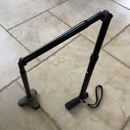Introduction: ConverTable
Materials List:
(1) 2' by 4' piece,
(2) 8' 2x2s,
Power Drill,
Measuring Tape,
(4) 1 1/2" flat hinges,
(8) 4" flat brackets,
(4) 4" L-brackets
Step 1: Preparation
Cut your 8' 2x2s down into pieces of 1 and 2 foot measurements.
Your resulting materials should now include:
(6) 1' 2x2 pieces
and
(4) 2' 2x2 pieces
Step 2: Building the Legs Pt. 1
1. Attach a 4" L-Bracket to the side of one of your 1' 2x2 pieces.
- Pre-Drill holes that are marginally thinner than the width of your wood screws.
- Make sure to keep one branch of the L-bracket flat with the bottom of the 2x2.
2. Line the long edge of your 1' 2x2 up with the bottom edge of your 2' 2x2 to make and L-shape of your pieces and connect the other branch of your L-bracket to the new 2x2.
Again be sure to pre-drill holes so you don't split your wood.
3. Attach a 4" flat bracket to the side of your L-shaped leg where the end of a 2x2 is exposed.
- Be sure to have two screws in the end of your 2' 2x2 and the other two into the side of your 1' 2x2.
- Pre-drilling is key to success
4. Repeat three times until you have four L-shaped legs for your table.
Step 3: Building the Legs Pt. 2
1. Grab two of your newly created legs and use measuring tape find and mark the center of each.
- Should be at the 1' point
2. Using one of the two remaining 1' 2x2s, line it up perpendicular to your 2' pieces where the center of its width is lined up with your marks. This should create an H (or I) shape that will connect the two legs and make a set.
3. Using two 4" flat brackets, fasten the 1' 2x2 to each leg which should connect the whole set into one piece.
- Be sure that two screws go into the sides of each leg and two (afterwards a total of four) go into the connecting piece.
- I put my flat brackets on what would be the back of the L-shape, but it is up to you
- Additionally you could use four flat brackets on each side for support but that is again up to you.
4. Repeat with your remaining parts to construct two sets of stable legs.
Step 4: Legs to Tables
1. Using two 1 1/2" flat hinges, attach one side (of each) to the top edge of your L-shaped legs where the unconnected hinge is facing backwards from your legs.
2. Measure in, roughly 1' from each side (length-wise) of your 2' by 4' piece that will become the surface of your table.
3. Measure in roughly 4 1/2" from either side (width-wise) to mount the legs of your table on.
- These measurements will rely on the precision of your cuts/construction of the legs thus far and may need to be adjusted case-by-case.
- The Idea is to have the legs mounted in the center width-wise and, when the table is complete and in the taller mode, that the base of the legs(the edge of the short branch of the L of you legs) are about 1" apart.
- Always double check your measurements.
4. Attach the loose hinge side to the underside of your table surface where the short branch of your L-shaped legs is facing toward the center of your table, length-wise.
- Optional step: I had painted my legs black by this point in the process but this is not necessary to do. Just maybe more convenient in the end.
5. Repeat for the other leg.
Step 5: Finishing Touches
Sand EVERYTHING. (Or, at least all sharp edges and splintering surfaces.)
Paint it / Stain it / Finish it - this will only effect the final look of your table and is completely up to you. I opted to go solid black.
Optional:
I cut out circular pieces at the ends of my table (width-wise) for easy lifting and to serve as signifiers as to what the table might do.
- To do this I found a roll of painters tape to serve as my guide for a small circle.
- I used a saw to cut out the piece and then sanded and painted.











